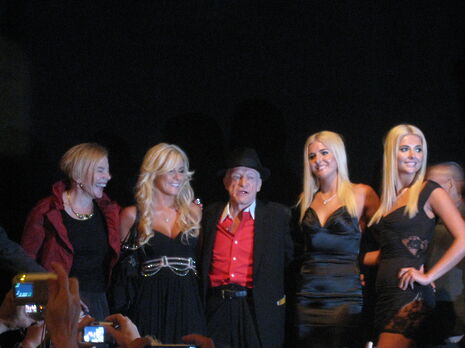Hugh Hefner encouraged a pernicious culture of mistreatment of women
Three weeks after his death, and amid the revelations about Harvey Weinstein, Eve Hodgson says the Playboy creator is largely responsible for the way modern men think they can treat women

The death of Hugh Hefner at the end of September generated the definition of a mixed mood. On one hand, he was celebrated as the emancipator of women’s sexuality and sexual bodies. On the other, he was criticised for his creation of the hyper-sexual female figure.
People who subscribe to the first mind-set often hail Hefner as a ‘legend’ – a man living the life every man wants to lead.
He is not. He cannot be remembered fondly in any narrative which values women and the way they are perceived in wider society.
Playboy was founded in 1953, and its first issue used nude photographs of Marilyn Monroe without her consent. The ‘men’s lifestyle magazine’ was continually popular. They certainly employed some stellar writers who produced incredible pieces that may have been the cause for some of this attention – including an interview with presidential candidate Jimmy Carter where he admitted his penchant for adultery.
“Hefner’s behaviour, and his entire career, clearly demonstrates he was only interested in the sexual liberation of men, not women”
However, the fundamental success of Playboy, and the reason Hefner is celebrated as a legend rather than scorned as a disgusting and exploitative old man, was because of its publication of photographs of naked or nearly naked women.
Women choosing to enter sex work can be an independent decision, and can be an empowering, emancipating choice. However, often, female sex workers can be exposed to a world that is full of coercion, and can cause them physical, psychological, and emotional harm.
Hugh Hefner not only allowed this to happen to his ‘playmates’, but he encouraged and enjoyed their submission and degradation.
Perhaps the most intense account of life in the Playboy mansion is that of Holly Madison, in her book Down the Rabbit Hole. She speaks from a position of authority on the issue. At the age of just 21, she became the 74-year-old Hefner’s “number 1 girlfriend”, and remained in that intimate position for six years.
She describes how, in her early days in the community, she could not understand other playmates’ lack of enthusiasm. She highlights her own ignorance as an outsider – an ignorance perhaps shared by many who celebrate Hefner – that the girls were required to have sex with him.
Hefner’s alarming treatment of the women who worked for him signifies wider problems with his attitudes towards women in general. Madison describes how he offered her quaaludes, sedative pills that he called “thigh-openers”. This indicates Hefner’s total disregard for his employees’ wellbeing, and their consent to sexual activity with him.
She also recounts the group sex sessions that were a usual element of the rigidly scheduled Wednesday and Friday ‘club nights’. Two of the other women involved, Jill Ann Spaulding and Kendra Wilkinson, both of whom have written on their time at Playboy, highlight the entirely artificial nature of the sex – “it was like a job”.
Hefner is often lauded as the figurehead of the sexual revolution that was swept in with the swinging 60s. However, his behaviour, and his entire career, clearly demonstrates he was only interested in the sexual liberation of men, not women. The Playboy lifestyle did not emancipate the women involved, it kept them quite literally behind bars.
They were required to be back in the mansion at 9pm every night when they were not scheduled to accompany Hefner. There were to be no boys allowed. He vetted their social media presence. He used their ‘allowance’ as a stick to beat them with when they did not obey him.
The passivity of Playboy models in the photographs that fill the magazine makes them a blank canvas for men to project their sexual desire onto. It also creates an image of the sexually desirable woman that is not realistic or attainable.
Those women involved in Playboy are not wrong for the job that they chose: Hefner used his wealth and power to exploit many who believed themselves to be representative of a force for good.
Furthermore, Hefner contributed to the large-scale normalisation of sexually objectifying women. When soft porn, especially borne of an environment like Playboy, can be bought and sold as easily as a newspaper, that sends a message that is not liberalising or revolutionary at all.
It is fundamentally damaging to the way men perceive women, as it becomes perfectly acceptable to see them as their highly sexualised nude bodies. It created a wider porn culture that presents unrealistic sex and damages young people’s sexual wellbeing. Hefner did not care.
The legacy he leaves behind would be better off righted or expunged than celebrated
 Comment / Plastic pubs: the problem with Cambridge alehouses 5 January 2026
Comment / Plastic pubs: the problem with Cambridge alehouses 5 January 2026 News / SU stops offering student discounts8 January 2026
News / SU stops offering student discounts8 January 2026 Theatre / Camdram publicity needs aquickcamfab11 January 2026
Theatre / Camdram publicity needs aquickcamfab11 January 2026 News / News in Brief: Postgrad accom, prestigious prizes, and public support for policies11 January 2026
News / News in Brief: Postgrad accom, prestigious prizes, and public support for policies11 January 2026 News / Cambridge academic condemns US operation against Maduro as ‘clearly internationally unlawful’10 January 2026
News / Cambridge academic condemns US operation against Maduro as ‘clearly internationally unlawful’10 January 2026









